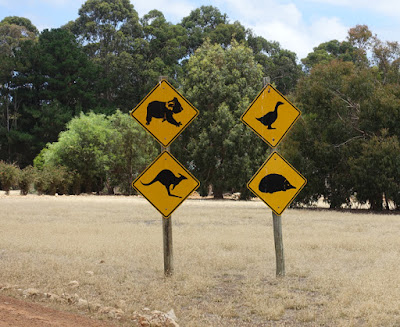 |
| Remarkable Rocks, Kangaroo Island, South Australia |
For many years, people have told us--if you like watching wildlife and spending time outdoors, you should go to
Kangaroo Island. So we did. And we were rewarded with plenty of bird and animal sightings plus opportunities to hike and explore the many trails and beaches, taking hundreds of photographs along the way. Located a short distance (a 45 minute ferry ride) off the Australian coast south of Adelaide, Kangaroo Island stretches more than 100 miles from end to end. It is the third largest island in Australia (after Tasmania and Melville Island in the Northern Territory) and more than a third of it is dedicated to parks and wilderness protection areas.
 |
| Bottlebrush |
We arrived in December at the beginning of the Australian summer, but before the busy holiday season, so at many of the places we visited we saw few other people. We spent five nights on the island, two at the east end, making our base near Penneshaw, and three nights at the west end, staying at the Kangaroo Island Wilderness Retreat, close to the entrance to Flinders Chase National Park.
 |
| Galahs, a kind of cockatoo, are common in Australia and often considered to be pests |
After getting off at the ferry landing we stopped in Penneshaw at the Kangaroo Island Visitor Information Center, which is packed with brochures, maps, and helpful people at the desk. Our first and last nights were at the Figtree B and B at Baudin Beach a few miles up the road. After dinner that night at the Penneshaw Hotel in town, we came back to find cockatoos roosting on the wire overhead and a kangaroo calmly munching plants right in front of our porch. (Kangaroos are found all over the island, but seen mainly at dusk and dawn.)
 |
| Beginning of Beach and Bush trail in American River decorated with feathers found by hikers |
On our second day we headed for American River to take a walk through the forest in search of endangered black cockatoos (which we never found) although we did spot a variety of water birds along the beach, including a flock of black swans. When we got back to our car we noticed a koala taking a nap in the eucalyptus tree right over the parking lot.
 |
| Oysters and King George Whiting fish sandwiches for lunch in American River |
For lunch we had fish and oysters, farmed locally. Throughout our stay in Kangaroo Island the food was fresh and delicious.
 |
| Displays in the Flinders Chase Park Headquarters tell about fossils of prehistoric marsupials found in the park. On the patio outside the visitor center kids can dig for "fossils" in a large sand pit. |
After lunch it took most of the rest of the afternoon to drive to the other end of the island, where, after checking into our hotel, the
Kangaroo Island Wilderness Retreat, we went to the Flinders Chase park headquarters to get maps, a parking permit, and advice on hiking and sightseeing in the park.
 |
| Numerous burrow entrances can be seen around the edge of the platypus pool--but no platypuses. |
The next morning we took the trail from the park headquarters to the platypus pools. It is almost impossible to see platypuses in the wild–they are nocturnal and spend most of their time under water. (The best place to see a platypus is in a zoo, which I have done.)
 |
| Rosenberg goanna. It can grow to be a meter long. |
But, even though we didn’t see any platypuses, we spotted numerous birds along the trail and had a surprise encounter with a very large lizard (a Rosenberg goanna) hunting for birds and small animals in the underbrush.
 |
| Cape de Couedic Lighthouse |
In the late afternoon we headed for Cape de Couedic and Remarkable Rocks, arriving as the sun was sending golden beams across the landscape. From the lighthouse at the top of the point we followed a long walkway down the cliff to Admirals Arch, a natural opening in the rocks framing the beach on the other side. Below the path we could see and smell hundreds of fur seals jousting with one another at the edge of the waves.
 |
| Fur seals at Cape de Couedic |
On our flight to Australia we had watched a film called
December Boys, about four orphans from the outback having a summer holiday at the beach. It was filmed mostly on Kangaroo Island and was the perfect preparation for our trip. A key part of the story takes place at Remarkable Rocks.
 |
| At Remarkable Rocks at sunset |
After visiting Cape de Couedic went back to the turnoff for Remarkable Rocks, drove the short distance to the parking area, and took the path to this amazing natural phenomenon. The giant rocks are perched on a natural platform above the ocean, as if placed by giant hands. We were buffeted by a warm summer wind, but it was not hard to imagine how harsher winds, rain, and sand had sculpted these fantastic shapes over time. It was the perfect ending to our third day on Kangaroo Island.
Part 2 of our stay on Kangaroo Island to be posted next week.













































